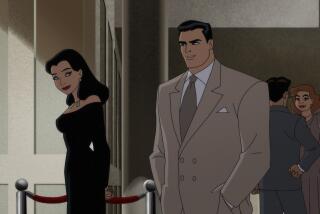The Comic Book Grows Up : Graphic Novels--’comics for adults’--are enjoying immense popularity . . . but why?
King Arthur, the model of chivalric virtue, leads the valiant knights of the Table Round into battle once more. But things have changed: The Once and Future King has been transformed into a 6-foot-3 Hercules who numbers a woman, a samurai and a mutant among his vassals. And their foes consist of a horde of green-skinned aliens.
Toto, I’ve got a feeling we’re not in Tintagel anymore.
For the record:
12:00 a.m. April 30, 1989 For the Record
Los Angeles Times Sunday April 30, 1989 Home Edition Calendar Page 99 Calendar Desk 1 inches; 34 words Type of Material: Correction
Readers Kim Thompson, Gary Groth and Steven Grant point out in “The Comic Book Grows Up,” April 16: that Frederic Wertham’s first name was given as Frank and that typographical errors appeared in the surnames of Klaus Janson and Art Spiegelman.
And we’re not. “Camelot 3000” by Mike W. Barr and Brian Bolland takes place in the not-too-distant future. While fleeing the destruction of London, Tom Prentice inadvertently awakens the slumbering King in his tomb. Through more than 250 pages of flamboyant pictures and hokey dialogue, Arthur, Merlin and an assortment of reincarnated warriors of the Table Round use sorcery and high-tech weaponry to save the world. Once Earth is again safe for democracy (and everything else), “The Road Goes Ever On,” as a tentacled creature on some other planet draws Excalibur from a stone, presumably to continue the fight for virtue. “Camelot” belongs to a strange literary/artistic hybrid genre that has come to be called the graphic novel.
Acclaimed as a new art form, damned as “comic books for adults,” graphic novels are easier to recognize than define. In look and subject matter, they often recall the flashy, trashy comics of the early ‘50s that led Dr. Frank Wertham to launch a clean-up crusade against what he saw as one of the principal causes of juvenile delinquency. But French intellectuals regard them as profound and artistic.
Basically, they’re baroque (in every sense of the word) comic books that feature larger formats, longer stories and more flamboyant artwork. Because they’re more carefully printed on higher quality paper than conventional comic books, graphic novels generally run between $8.95 and $12.95--higher than most paperback novels.
They are inheritors of a mixed bag of traditions, including the superhero comics of the ‘40s and early ‘50s, the raunchy underground “comix” of the ‘60s and the “Marvel Universe” of the ‘70s and ‘80s. They profoundly reflect the influence of the movies, notably the dark, shadowy look of film noir detective mysteries, the elaborate special effects of “Star Wars” and the raging vigilantism of Stallone and Bronson.
“Superheroes are always fascists--there’s a strong streak of social Darwinism that runs through superhero comics,” says Pulitzer Prize-winning cartoonist Jules Feiffer, who began his career as an assistant on the comic book “The Spirit.” “In the comics, the law is always ineffectual and the Bill of Rights is a pain in the ass: To get anything done, you have to kill first and ask not many questions after. Reagan was the perfect president for superheroes.”
“It’s a bastard term for what’s traditionally been regarded as a bastard medium,” says Gary Groth, the publisher of Fantagraphics Books. “(It was) created by somebody in marketing to encompass cartoon collections, long comic books and collected short comic stories that are sold in book form. I’d be surprised if more than a half-dozen books out there could legitimately be called graphic novels.”
However defined, the graphic novel has provoked the first aesthetically serious discussions of the comic book as an art form in America since the debut of the underground comics in the late ‘60s.
“In a properly done graphic novel--by my standards--the art and words are seamlessly integrated, so that you have a unified whole,” adds Will Eisner, the creator of “The Spirit.” “So true graphic novels are few and far between, but the market needs a way to identify them: Comics ceased to be comical long ago, but they’re still called ‘comics.’ ”
While the concept and content of graphic novels are debated, their growing popularity is not.
Epic Comics alone publishes more than 50,000 copies of 12 different titles each month. “The Dark Knight” and “Maus” have sold approximately 100,000 copies apiece, and remain in stores more than two years after their initial publication.
The demographics of these sales are also significant: While pre-teen boys buy most comic books, graphic novels appeal to older, more sophisticated readers. The media campaigns surrounding the upcoming films based on “Batman” and “Dick Tracy” are likely to spur a renewed interest in the comics and, concomitantly, in graphic novels. Frank Miller is already making the transition from graphic novels to films: He’s writing the screenplay for the sequel to “RoboCop.”
“As more graphic novels and limited series are issued in trade paperbacks, I think the form will increase its appeal to movie people,” says Archie Goodwin of Marvel’s Epic. “Trying to boil an entire run of a superhero comic into one movie is tough; graphic novels offer something more manageable that has a greater potential for theatrical films or TV movies. I think we’ll be seeing more cross-pollinization between the media.”
Although Americans have only recently begun to read them in quantity, graphic novels have been popular for decades in South America and Europe. In Paris, the rage for these florid fantasies has led book dealers in the swankiest arrondissements , college bookstores and street corner newsstands to devote large sections to them. In Rio and other Latin American cities, elegantly dressed professionals read them on trains and buses.
In Japan, more than 1 billion manga or comic books are sold each year--up to one-third of all the books and magazines published there.
Most American graphic novels are closer in tone to the comic-book action of the new Batman, “The Dark Knight,” (see panels opposite and this page) than the more highly personal narrative of Art Spiegelman’s “Maus,” which offers a fictionalized account of his father’s experiences during the Holocaust in Poland.
In the four-part “Dark Knight” series, Miller transforms the familiar, blandly virtuous superhero into a bitter, disillusioned anti-hero. At 55, billionaire Bruce Wayne emerges from retirement to battle evil in the grimy, crime-ridden megalopolis of Gotham City. Assisted by a new Robin--a semi-punk teen-age girl--Batman fights not only his old nemesis, The Joker, but obnoxious, liberal defense lawyers, pop psychologists and TV commentators who complain about his vigilante tactics.
In “Rolling Stone,” Mikal Gilmore said Miller’s work had “served to expand the artistic and storytelling ranges of the American mass-market comic book, forcing the medium to accommodate fresh, dramatic visual styles and bold thematic twists” and “helped raise new hopes within the industry for the maturation of long-devalued art form.”
But Feiffer objected to the vigilante tone of Miller’s story:
“ ‘The Dark Knight’ is graphically beautiful, but it seems to me to be primarily a complaint about middle age. If it’s graphic novel, it’s a rather paltry one--gorgeously illustrated, but shoddily thought out.”
Far away, across a gap bridged only by ink and human imagination, a mouse watches his friends and relatives being rounded up for deportation and death. In this version of Poland, 1943, mice represent Jews and cats Nazis, and the fires of the Holocaust are burning.
In contrast to the bold colors and theatrical, comic-book graphics of “The Dark Knight,” Spiegelman uses the liney, black and white Rapidograph style of the underground comix in “Maus: A Survivor’s Tale,” which depicts the life of a Jewish mouse from the beginnings of the Nazi persecutions through his arrival at Auschwitz in 1944.
Although limited in its visual impact by Spiegelman’s simple drawings, the intensely personal tone gave “Maus” a compelling force. Nominated for a National Book Critics Circle Award, “Maus” was praised in the New York Times for “almost singlehandedly blurring the line between adult books and comic books.”
The stories in the Japanese manga range from familiar science-fiction epics to period dramas (Occidental and Japanese) to the victories of ace sushi chefs, mah-jongg champions and pinball wizards.
Comic-book-style graphic novels do feature more explicit violence and sex than standard comics. Heros with biceps that rival Arnold Schwarzenegger’s punch, shoot and blast their enemies to smithereens.
The voluptuous heroines invariably lose their blouses, but the American characters rarely manage to get into bed. Foreign stories are racier. Graphic novels are generally tamer than contemporary films and would barely qualify for “PG” ratings.
The dominant comic-book sensibility vexes many people in the field, who see it as an impediment to the legitimization of the medium in America.
“Every area of the arts constantly produces a large percentage of trash, and it’s no different in the comics,” says Eisner. “There’s no question that a great many artists in the comics turn out work with the same lack of responsibility--artistic, creative and social--as the people who make movies. For every ‘On Golden Pond,’ you have a dozen ‘Rambos.’ ”
Groth and Eisner prefer the more personal work of Spiegelman and the other young artists; Feiffer describes their output as “reminiscent of the Off-Broadway movement in the mid-to-late ‘50s.” Although he agrees that Americans need to overcome their condescending attitude toward the comics as a medium, he cautions, “to be taken as seriously as short-story writers or novelists, cartoonists must strive for the same dimension, the same level of seriousness.”
More to Read
The biggest entertainment stories
Get our big stories about Hollywood, film, television, music, arts, culture and more right in your inbox as soon as they publish.
You may occasionally receive promotional content from the Los Angeles Times.










